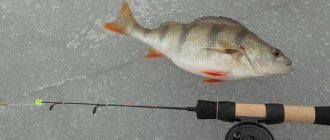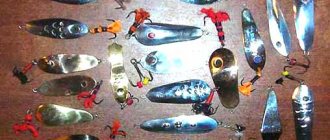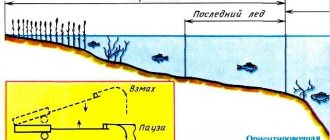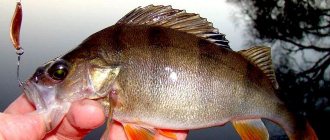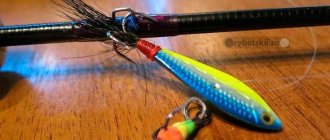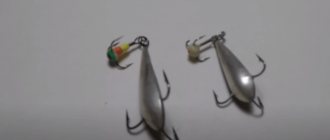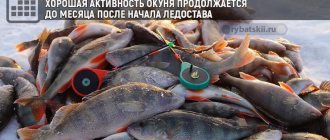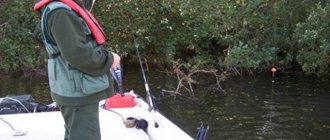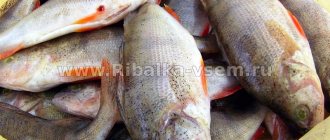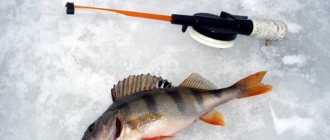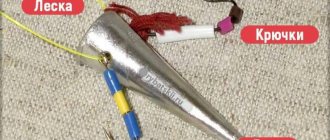03/07/2021 429 Winter fishing
Author: Alexander
Winter lures for perch differ from baits for other types of fish only in size. The choice of spinner is determined by the depth of the reservoir and the current. For example, in January, perch, like trophy humpback salmon, is caught using a spinner with a narrow body and noticeable weight, because the process takes place at great depths.
[Hide]
When and how to catch perch using lures in winter
You can start trolling as early as a week after the river freezes, but the most successful period for catching a predator is considered to be the end of winter, when the fish need to gain strength after the cold weather.
Winter perch fishing is divided into certain periods, depending on which the fisherman’s actions change:
- At the beginning of winter, when the ice is not yet thick enough, “minke whales” live close to the shore. The peculiarity of this period of time is that, despite the rather greedy bite, you still have to look for fish, at least if your goal is large prey.
- In the middle of winter. Perch can be found throughout the entire area of the reservoir; predators are divided into schools of no more than seven individuals. Using the reconnaissance method, places with the most intense bite are found, and subsequently the fisherman will simply need to find these points on the reservoir again.
- In February. The accuracy of determining the position of a perch reaches one and a half meters. At this time, the ice is already quite thick, and the angler will have to drill for sure.
An important element of almost any fishing is bait; its main purpose is to keep the school near the hole. Ideally, bait is carried out a day or two before the fishing itself, in this case the chance of success of the event increases significantly. For perch, store-bought food bloodworms are best suited. If it is possible to grow live bait in an aquarium, then this option is no less useful: live bloodworms will attract fish for a long time by burying themselves in the ground.
How to make a spinner with your own hands?
Due to the fact that there is an abundance of all kinds of fakes on the market, and prices for branded sporting goods are quite high, some fishermen prefer to make spoons from scrap materials. Despite the fact that the drawings of spinners for different types of fish may be the same, craftsmen make qualitative changes to the adjustment of the plate, which ensures its guaranteed reliability.
A homemade spoon, even of low quality, is a good chance for beginners to try themselves in this business by first catching small perch.
Algorithm of actions
Technology for making a spinner for winter fishing from a tin can:
- Cut a straight sheet of metal using special scissors. After which the paper, paint and other unnecessary elements are removed.
- On the sheet, draw and cut out the shape of the future spinner with scissors.
- Remove burrs using sandpaper. Use an awl to make two holes for the winding rings. Thoroughly polish the lure.
- Give the bait the desired shape using a spoon or other handy means.
- Attach winding rings and hooks to the spoon. Apply appropriate designs with nail polish.
The creation of a catchy winter lure for perch is clearly demonstrated in the video from the Fishing channel with Romario Agro.
How to make the best catchable bait for winter fishing: instructions and drawings
From a spoon
To make a winter spinner from a spoon you will need the following:
- Materials:
- dessert cupronickel or silver spoon;
- winding rings;
- treble hook.
- Tools:
- hacksaw for metal;
- file;
- needle files;
- drill;
- pliers.
Step-by-step instructions for making a spinner from a spoon are as follows:
- The handle or handle is cut off from the spoon.
- Process the edges of the cuts.
- Drill holes in the front and back of the workpiece.
- The spoon is equipped with winding rings and a tee.
- They give the spoon a bend, thereby achieving the necessary game.
Expert opinion
Knipovich Nikolai Mikhailovich
Zoologist, hydrobiologist. I am interested in fishing at a professional level.
From a seemingly unnecessary part of a spoon or “slurp” you can make a catchy oscillating spoon for fishing in open water. To do this, two holes are also drilled and the workpiece is equipped with rings and a tee.
From a beer can
An empty can of beer, soft drink or canned food can also serve as material for making a winter lure for catching perch. An aluminum can must be used. The result is light spinners for fishing in shallow water.
To make such a spinner you will need the following:
- Drawing. The drawing shows the shape and dimensions of the future spinner. Then the outline of the workpiece is cut out of paper.
- Materials:
- empty jar;
- winding rings;
- treble hook.
- Tools:
- metal scissors;
- awl;
- hammer;
- file;
- sandpaper;
- soldering iron
How to make a spinner from a can:
- Cut the can and level the sheet with a hammer.
- Apply a pattern with the outline of the spoon and trace it with an awl.
- Cut out the workpiece.
- The edges and surface of the workpiece are processed.
- Two holes are pierced: in front and behind the workpiece.
- Give the spoon the desired bend by attaching the workpiece to some round object, for example, a wooden rolling pin.
- The lure is equipped with rings and a tee.
- If you need to make the lure heavier, a layer of solder is soldered onto the inner surface.
Expert opinion
Knipovich Nikolai Mikhailovich
Zoologist, hydrobiologist. I am interested in fishing at a professional level.
A spinner with a soldered single hook can be no less effective. Then to make the bait you will additionally need solder, phosphoric acid and a soldering iron.
From tweezers
Tweezers make nail-type spoons or jigs. You can make a large bait from medical tweezers or a small one from a tool used by radio amateurs and electronics engineers. A drawing for making such a bait is not required, but this is what is needed:
- Materials:
- metal tweezers;
- winding rings;
- treble hook.
- Tools:
- hacksaw for metal;
- file;
- needle files;
- sandpaper;
- drill;
- pliers.
Making a winter spinner for catching perch using tweezers is carried out as follows:
- A workpiece of the required length is cut out of tweezers, and 2/3 of it should have a smooth surface, and 1/3 should have a grooved surface.
- The workpiece is processed.
- Drill holes.
- The lure is equipped with rings and tees.
- They bend the spoon so that it plays as needed.
Castmaster
Anglers who tried ice fishing with the famous Castmaster from the American company Acme were amazed at its catchability.
Expert opinion
Knipovich Nikolai Mikhailovich
Zoologist, hydrobiologist. I am interested in fishing at a professional level.
However, the cost of the original spinner is noticeably on your pocket, and making a homemade Castmaster is not so difficult.
There are two ways to make this bait: from a solid metal rod and from a tube.
To obtain bait from a solid rod you will need the following:
- Drawing. The drawing indicates the size of the bait and, most importantly, the cutting angles, which should be 17 and 23 degrees for the resulting lure to resemble the original.
- Materials:
- Metal rod of the required diameter. Materials: copper, brass or stainless steel.
- Wind-up rings.
- Treble hook.
- Tools:
- hacksaw for metal;
- protractor;
- file;
- sandpaper;
- drill.
How to make a homemade Kastmaster:
- Cut the workpiece, observing the cutting angles.
- Process the workpiece.
- Drill holes for the rings.
- The spoon is equipped with winding rings and a tee.
If you intend to make a spinner out of a tube, you will have to stock up on tin or lead. Having cut the blank from the tube, tin or lead is poured into it, and then the holes are drilled and the spoon is equipped with winding rings and a tee.
Expert opinion
Knipovich Nikolai Mikhailovich
Zoologist, hydrobiologist. I am interested in fishing at a professional level.
However, for fishing at shallow depths, you can use a hollow tube spoon.
Rotating
A vertical spinner for catching perch from ice can rotate around its axis during the pause following the release. Some symmetric trihedrons have a similar game. The secret of production is known only to their designers.
From an electrical cable
Winter triangular spinners are made from electric cable , in which one side is wide and the other two are narrower, i.e. in cross-section, such a spoon looks not like an equilateral, but an isosceles triangle. By the way, you can successfully catch asp with such spoons in the summer. To make this bait you will need the following:
- Materials:
- a piece of electrical cable with a diameter of 1 cm and a length of 6-7 cm;
- winding rings;
- treble hook.
- Tools:
- hacksaw for metal;
- file;
- sandpaper;
- drill.
The process of making a spinner from a cable looks like this:
- Saw off the workpiece to the required length.
- Grind down the edges.
- Drill holes.
- The lure is equipped with rings and a tee.
"Malek"
The Malek spinner is a rather original product, which has no analogues among store-bought spinners. What is needed to make it?
- Drawing. To make it easier to make a spinner, first draw a drawing. The length of the spinner is usually 5 cm, the width at the front end is 3 mm, at the rear end it is 8 mm.
- Materials:
- corrugated metal plumbing pipe;
- winding rings;
- treble hook.
- Tools:
- metal scissors;
- file;
- grinding paste;
- drill.
Such a spinner is made as follows:
- Cut out a pattern from thick paper or cardboard.
- Cut the pipe lengthwise and cut out a piece of approximately the required size.
- Having applied the pattern, the workpiece is sawed off from the pipe.
- Process the workpiece.
- Drill holes.
- The lure is equipped with rings and a tee.
Expert opinion
Knipovich Nikolai Mikhailovich
Zoologist, hydrobiologist. I am interested in fishing at a professional level.
Due to the transverse ribs, the Malek has a unique game, which makes it extremely catchy.
"Dovetail"
“Dovetail” is a much more complex design, which, however, does not require the use of dies and punches. To make it you will need:
- Drawing. A pattern is cut out 90 m long and 30 mm wide with a tail cutout of 25 mm.
- Materials:
- sheet copper;
- orthophosphoric acid;
- solder;
- single hook;
- thin copper wire.
- Tools:
- metal scissors;
- file;
- soldering iron;
- awl;
- sandpaper.
Dovetail is made like this:
- Cut out the blank according to the template.
- Solder the workpiece from the inside.
- Using an awl, draw a straight line through the middle and bend the workpiece in half lengthwise.
- The tail processes are brought together, forming something like a boat, and soldered together.
- Make a loop of wire and solder it from the inside at the front of the workpiece.
- Solder the hook at the back of the workpiece.
- Fill the internal space with solder.
- Processing the spinner.
"Torpedo"
“Torpedo” is a bait that is more complex to manufacture, since it has two sides made of the same or different sheet metals.
You will need the ability to solder and give the lure the desired shape using a matrix. To make a Torpedo you will need the following:
- Drawing. On thick paper, draw the outline of the future spinner, resembling an elongated overturned drop. For fishing at shallow depths, the spoon has the following dimensions: length 50 mm, width at the top 10 mm, width at the bottom – 3-5 mm. If you plan to fish at greater depths, the dimensions are proportionally increased.
- Materials:
- sheet of non-ferrous metal;
- wooden block;
- orthophosphoric acid;
- solder;
- copper wire;
- winding ring;
- treble hook.
- Tools:
- metal scissors;
- soldering iron;
- rubber hammer;
- sandpaper;
- file.
The manufacturing process of the Torpedo is as follows:
- A recess of the desired shape is made in a wooden block.
- Cut out two sides of the future spinner.
- Give them the required shape.
- Loops are soldered from the inside.
- Fill the space between the two edges with solder and solder them together.
- The workpiece is processed and polished.
- The spoon is equipped with a winding ring with a tee.
Making other homemade spinners requires even more skill.
Unhooked
A winter spinner without hooking is needed when a predator is hiding in a snag , and catching it with baits with open hooks is fraught with losses of spinners.
A non-hooking spinner can be made from any bait with a hanging hook, replacing the latter with a tee with a wire protection, which can be purchased at a fishing store. However, small hooks can be difficult to find. We can recommend using an offset hook with a small twister attached to it.
It has been customary for a long time to use homemade lures for perch for winter fishing. This was not due to a good life, since it was unrealistic to purchase a more or less catchy lure in a store in Soviet times.
Today, making homemade lures for catching perch from ice has become a separate area of the fishing business, but if desired, any angler can make a simple bait from scrap materials and successfully catch striped robbers with it.
Main types of perch spinners
Anyone who wants to test their strength in trolling must know the types of bait action depending on its variety. The behavior of the bait can be divided into four characters.
Gvozdik
This type of spinner got its name because of its vertical fall and is well suited for catching active perch. The bait is lowered to the bottom of a reservoir up to two meters deep, then a smooth rise of 15-30 centimeters is carried out and dumped.
Gliding lures for perch
Gliding or floating spoons are distinguished by their oscillation. Such baits fall in a horizontal position and go a decent distance from the hole. Externally, it is distinguished by concavities and convexities on the body, as well as noticeable curvature. The weight of such a spoon is less than a nail, and the permissible depth for effective fishing is from five to six meters. The bait slowly rises to a level of up to sixty centimeters and drops sharply.
Loose spoons
In the manufacture of such baits, technologies are used to shift the center of gravity to the middle of the product and symmetry of the sides with an acute angle in the center of the entire length. The fall is also different from other types; it occurs slowly in a horizontal position at the bottom, while the spoon creates small oscillatory movements. The bait slowly rises to any height and is dropped abruptly; in this case, throwing should be avoided.
Spinner "Step"
Another type of bait for winter trolling of perch. Externally it is a narrow strip with a concave shape. The game is played with a short swing and a sharp release of the spoon.
Photo gallery
Character of the game "Carnation"
Character of the game "Floating"
Character of the game "Step"
Character of the game "Lypuchka"
Do-it-yourself spinner for perch - simple production of catchy baits
The assortment of fishing stores includes baits for every taste, but many amateurs continue to make spinners with their own hands. The resulting baits are in no way inferior, and sometimes even superior, to store-bought baits.
All that is required is the necessary materials, simple tools and a little free time.
Perch is a freshwater predator, widespread in Russia. Scientists distinguish two types of this fish:
- small or “grassy”;
- large or “deep”.
They differ in size, rate of weight gain, location in the reservoir and preferred food.
The “grass” perch rarely exceeds 15 centimeters in the back, does not gain more than a few hundred grams, and lives in shallow waters, where it feeds on fry and insects. To catch it, it is better to use traditional baits - bloodworms, maggots, live bait, etc.
Large perch has a “royal” size - up to 50 centimeters or more, heavy weight - up to 2.5 kg, lives in pools and holes. It feeds mainly on other fish, even its small relatives. To catch this particular type of predator, spoons are mainly used.
Based on the division, there are several differences between spinners for catching perch compared to other lures:
- Size. Large fish successfully bite on bait up to 10 centimeters long. The size of the spoon should be clearly visible at depth.
- Weight. As the name suggests, “deep” perch lives almost at the very bottom of the reservoir. The spoon must overcome the thickness of the water and its current. To do this, it must have a mass of about 3 - 5 g.
- Form. Like any other predator, perch will pay attention to bait that resembles its natural food. Ideally, a streamlined silhouette reminiscent of a fish.
- Color. Every angler, when going fishing, should have spoons of different colors with him. Basically, these are shades that differ from the general tone of the environment.
- Aerodynamic properties. Trophy fish hunt far from the shore, and only a balanced spoon can reach it.
- Additional details. Perch is a diurnal predator; anything can interest it: imitation scales, artificial eyes, false fins, etc.
A perch spoon is a metal or plastic plate to which fishing hooks are attached. The most important task of the bait is to attract the attention of the fish, but not scare it away. To do this, three main characteristics are important for any spinner: size, absence of visible danger and the effectiveness of the “game”.
A predatory fish will never attack a creature that is larger than it in size. Everyone chooses the length of the bait for themselves, depending on what kind of catch they are counting on. For quickly catching small or medium-sized perches, the optimal choice would be a spinner up to 5 centimeters . But if the preference falls not on speed, but on the quality of the catch, you should choose a larger bait.
In order not to scare away future prey, the spoon is camouflaged in every possible way. Hooks are hidden with feathers or special plastic elements . When painting, they give preference to bright, eye-catching colors, but do not use “acidic”, unnatural shades. For this purpose, the above additional details are used to give the spoon a resemblance to the food of a predator.
For successful fishing, it is important that the cast spoon does not hang around like a dead weight in the water. It should “play” - oscillate, imitating the movements of a feeding fish, rotate along an axis, arousing curiosity, or take a natural horizontal position, which, coupled with bright coloring, gives a good result. Therefore, the bait requires a correctly located center of gravity.
Spoons are divided into the following types, depending on the centering position:
- with the center of gravity at the bottom - the type most preferred by fishermen. Having deviated from the fishing line, the bait begins to make oscillatory movements;
- with the center of gravity in the middle - the spoon “hangs” in the water column and, with the help of the current, makes very natural movements that resemble the movements of a small fish.
The center of gravity may also be located at the top, but such spoons are not effective and are not in demand among fishermen, therefore they are not very common.
To achieve the desired centering, you can make part of the bait thicker than the rest or use additional elements, such as beads or ribbons.
Everyone creates a spinner for themselves, taking into account its distinctive features and characteristics.
When creating a spinner yourself, you should understand a few points that will help you avoid disappointment.
Firstly, there are no universal baits . A spoon that worked great in the summer, providing a rich catch in one body of water, may be completely useless in another. Not even the best bait will always work the same way. Secondly, when creating, you should take into account the characteristics of the reservoir where fishing will be carried out. It is necessary to evaluate such parameters as depth, water transparency, illumination, the presence of duckweed and vegetation, and the presence of obstacles to fishing.
For a good catch, the location of the school of small fish, which are the main food of deep-sea perch, is important.
- If there is no bite in the tested place, try feeding the fish or changing the fertilizer you are using . Most often problems arise from this;
- Make an attack point on the lure - a mark with bright paint or a plastic element. The bass will focus on it and be more likely to get hooked;
- In a homemade spoon, securely attach the hook . Poorly secured ones can slip out and the fish will leave;
- do not use dull hooks . This minimizes the number of idle bites;
- check the play of the spinners in the bathtub or aquarium . It is better to correct the shortcomings on the spot.
The advantages of artificial baits can rightfully be considered:
- fast, good bite at different times of the year and at any time of the day;
- opportunity for experimentation, combinations of different types.
A do-it-yourself bait according to all the rules will be able to outperform store-bought analogues. It’s not a matter of saving at all; a good homemade spoon will show better results and bring more joy from fishing. Moreover, if you consider that in stores there are many low-quality counterfeits of well-known brands.
Kastmaster spinner from Acme yourself. The great catchability of this bait is due to the precise cutting angles, thanks to which the bait actively moves.
- copper tube of the required diameter;
- tin.
- protractor;
- hacksaw for metal;
- soldering iron;
- drill with small drills;
- sanding paper.
Manufacturing algorithm
are marked on the pipe - 23 and 17 degrees . We cut out the future workpiece from a solid pipe with a small margin - the excess will go away during grinding. We fill the cavity with molten tin and wait for it to completely harden. We drill two holes along the edges of the spoon into which we will insert the winding rings. We grind and sand. The spinner can be left in its original form, or you can paint it to your taste. Attach the hook and line - the bait is ready.
This type of bait is made from a pure piece of metal - silver or copper. But you can do it yourself using surgical tweezers.
- hacksaw for metal;
- file;
- drill with small drills;
- sanding paper.
Even broken tweezers will do - you only need one of its “legs”.
Manufacturing algorithm
The required outline is cut out from part of the tweezers . A third of the future bait should be captured by the notches of the tweezers. The rest of the surface is smooth. Sharp, jagged edges are ground to a smooth surface. Along the edges there are two holes for winding rings and a fishing line with a hook. The workpiece is finally polished. We attach the resulting lure to the fishing line, attach the hook and get the finished bait.
Rating of the best spinners for winter perch fishing
The main country producing spinners is Finland, whose baits are of high quality and reliability. But there are other options.
With the opportunity for fishermen to communicate on various thematic forums, a conditional rating of the most profitable and catchy lures according to professionals has become available:
- Nils Master Hanski. A representative of Finnish models for catching perch and pike perch, the approximate cost of which is 470 rubles. A spinner with a chain and a triple hook, which is equipped with a rhinestone to attract the attention of a predator. The hook is also removable due to a special lock.
- Kuusamo Sinfonia. This spoon, costing 360 rubles, is intended for use in reservoirs with standing water. From the wide variety of models, it is worth highlighting a bait with a length of forty millimeters and a weight of 6 grams, with which you can also catch pike or pike perch.
- Kuusamo Kilpa-Loiste. It is an excellent option for small-sized bait costing 450 rubles. The surface of the bait is equipped with a special film that increases the visibility of the product due to the reflective effect.
- Kuusamo Leija. There are several variations of the spinner, but the universal bait is fifty millimeters long and weighs six grams. The design has additional blades that allow sudden turns. The cost of the product is 350 rubles.
- Kalamies 6 Hop-Mes. Quite an expensive spinner worth 650 rubles. It is distinguished by its impressive weight, due to which it is effective at a depth of up to eight meters.
- Hali Lindroos Luxus. An excellent bait with a corrugated surface structure, successfully used in muddy water. The price of the bait is about 250 rubles.
- Rapala Bergman BWB030 SG. Another spinner from the category of universal baits costing 350 rubles. Creates additional vibrations during vertical twitching.
- Rapala SM-Pirken SM45-SG. A product with an increased range of motion when playing. The pattern of red dots is designed to attract additional attention from the perch. The price of such a spinner is about 280 rubles.
- Rapala Arkku ARK 70 SG. A spinner with a tetrahedral surface and a classic oblong shape. Suitable for both calm water and fast currents. The cost of the bait is 400 rubles.
- Lucky John Scandy. A Scandinavian type spinner, the main material for the manufacture of which is brass, due to which the bait weighs six grams and is only five millimeters long. The price of the product is 350 rubles.
Making a spinner using a template
The method of making identical petals of homemade spinners using a template justifies itself if we constantly fish in the same places at approximately the same depth and current strength, without changing the diameter of the fishing line on the gear.
Then, having chosen three or four of the most effective winter lures for fishing, you can multiply them using petals cut out according to templates in case of probable breaks of hooked baits.
You can make a petal template for one vertical bait, say, with a large surface area, if you want to get a workpiece with an ideal contour relative to the longitudinal center line.
You will find such vertical winter lures in the archive with drawings of the petals of pike winter lures on the Main page of the site.
The most catchy lures for perch made in Russia
Top spinners from a domestic manufacturer:
- Aqua Shniaga. The main purpose of this bait is slow gliding at depth. The cost is 80 rubles.
- "Luck Pier No. 2." An inexpensive spinner that costs only 30 rubles. But despite its relative cheapness, it shows good results on various bodies of water.
- "Orlovskaya lure zander 07". A versatile bait with a ribbed surface for use in troubled waters. Due to its specific shape, the game of the spinner imitates the behavior of small fish. Also suitable for catching zander and pike. The approximate cost is 120 rubles.
- Russian Bait "Micro". An excellent spinner with a very complex and attractive game for predators due to the significantly lighter tail part of the bait. The product is also suitable for fishing in other fishing seasons. The price is 220 rubles.
- Eco Pro Favorit. You should choose this spoon only for reservoirs with calm water. It is characterized by sweeping movements when playing, which provokes even passive predators to attack. The cost is about 300 rubles.
Photo gallery
The photo shows various catchable spinners for winter fishing for perch.
Spinner "Nils Master Hanski"
Spinner “Kuusamo Sinfonia”
Spinner “Kuusamo Kilpa-Loiste”
Spinner "Kuusamo Leija"
Spinner “Rapala Bergman BWB030 SG”
Spinner “Rapala SM-Pirken SM45-SG”
Drawings of winter vertical lures for perch
If I have slightly intrigued you, then for better clarity of further material, download the archive with drawings of my homemade products - winter lures for perch, samples of which are presented in the photo.
From the archive, to present the material on the following pages, we will need drawings of some vertical perch baits. Links to archives of drawings of homemade winter zander and pike spinners are on the main page of the site.
However, I’ll make a reservation right away - the name of homemade baits for catching perch in winter fishing is purely arbitrary; In total, a lot of pike perch were caught using so-called perch spoons. It happens that pike and grapplers are interested in vertical perch spoons.
You can evaluate the deployment of homemade spinners in conditions close to catching perch in a body of water without a current in the video at the bottom of the page. But first, I’ll introduce you to the appearance of one of the homemade winter lures for perch within the boundaries of the drawing, copied at random from the archive.
Video
As preparation and training, the Men's Company channel has prepared material about catching perch with spoons during the opening of the winter fishing season.
Loading …
Was this article helpful?
Thank you for your opinion!
The article was useful. Please share the information with your friends.
Yes
No (100.00%)
X
Please write what is wrong and leave recommendations on the article
Cancel reply
Rate the benefit of the article: Rate the author ( 2 votes, average: 2.50 out of 5)
Discuss the article:
production of winter spinners for catching perch in shallow water
Making winter spinners for perch. Hi all! Today I want to tell you about making two winter lures for perch fishing. Dovetail 25mm.
These two spoons have proven themselves well in catching perch in shallow water up to 1.5 m. I make them in a size of 25 mm. And so let's start: Drawing of spinners with dimensions
We transfer the drawing to a regular notebook sheet in a box, this is what we get:
We carefully cut out with scissors not a square, but just a square with a margin, this will be needed in the future for easier bending of the crown in a vice and paste it onto a sheet of metal that we use for making winter lures. We use regular stationery glue.
We cut out the same squares from metal along the edge of the glued paper. The metal is quite thin, so for cutting it is enough to use ordinary stationery scissors. This is how we get the blanks:
Then we clamp these blanks into a vise along the bend line and bend them at 90 degrees. And with scissors we cut off all the excess around the office, after cutting out the paper can be removed, and the spoon has a dovetail, this very tail that turned out after cutting needs to be brought together, this is what happens:
